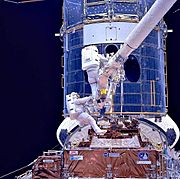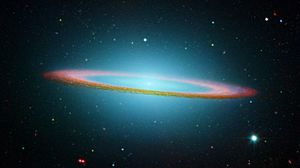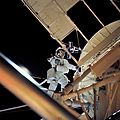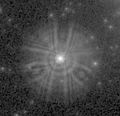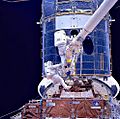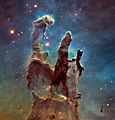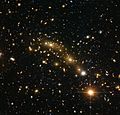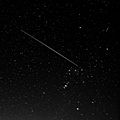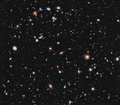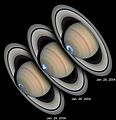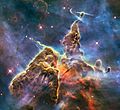Hubble Space Telescope facts for kids
The Hubble Space Telescope (HST) is the first large space observatory that uses light to see. It floats high above Earth's atmosphere. This means it can take much clearer pictures of the sky than telescopes on the ground. Our atmosphere makes starlight blurry before it reaches us. The telescope is named after a famous astronomer, Edwin Hubble. It can observe the universe 24 hours a day! Its main mirror is 94.5 inches (2.4 meters) wide. Hubble can photograph things so far away that it would be almost impossible to see them from anywhere else.
The Hubble Space Telescope was built by both NASA and the ESA working together. It orbits about 600 kilometers (370 miles) above Earth in space. It was launched on April 24, 1990. Like other objects in low Earth orbit, it travels super fast, about 10 kilometers (5 miles) per second. If you could go that fast on Earth, you'd travel from New York to San Francisco in just 10 minutes! This incredible speed makes it tricky to plan when to take pictures.
The Hubble telescope is about the size of a large school bus. But it's still small enough to fit inside the cargo bay of a Space Shuttle. It had to be fixed in 1993 because its pictures weren't clear enough.
Contents
Launching Hubble
The telescope was sent into space in 1990 by a space shuttle. When it reached its orbit, everything seemed fine at first. But there was a problem with the telescope that wasn't found until it started taking pictures.
The Problem with Hubble
When the Hubble Space Telescope took its first pictures, astronomers were excited. But the images were not as sharp and clear as they had hoped. Telescopes in space should take much better pictures than those on Earth. However, Hubble's pictures weren't any better. Scientists soon found a problem with the telescope's main mirror.
The mirror was not curved perfectly. It was only off by a tiny amount, about 2.2 microns. To give you an idea, that's about 1/50th as thick as a piece of paper! Even this small error was enough to make the images blurry. Some people joked that Hubble was "nearsighted".
Fixing Hubble
Another space shuttle mission was quickly planned to fix the space telescope. The repair was not easy! Astronauts had to install some small mirrors to correct the light coming from the big mirror. The main mirror could still be used. This repair took five days of space walks. During one of these walks, an astronaut opened a door on Hubble to install a new camera, but the door wouldn't close! The astronauts had to be very clever to solve this problem. Eventually, Hubble was fixed.
Hubble has been repaired and serviced five times. These missions helped keep it working and made it even better as technology improved. The space shuttle program even continued longer than planned just to send one last repair trip to the Hubble Space Telescope.
Hubble's Amazing Discoveries
- In 1994, Hubble looked at what scientists thought was an empty part of space for ten days. It found many faint and very distant galaxies there! No other telescope could have seen them.
- In 2004, Hubble looked back billions of years. It saw some of the very first galaxies in a famous image called the Hubble Ultra Deep Field.
- Hubble helped scientists figure out the age of the universe. Before Hubble, they only knew it was between 10 and 20 billion years old. Hubble helped narrow it down to about 13.7 billion years.
- It took the first picture of a planet outside our solar system. It also helped find out what kind of atmosphere other planets might have.
The Future of Space Telescopes
The Hubble Space Telescope will eventually be replaced by the James Webb Space Telescope. This new telescope will be located even further from Earth. There are already other telescopes in orbit, like the Herschel Space Observatory and the Kepler Spacecraft. Kepler was specially designed to find Earth-like planets around other stars.
Images for kids
-
Astronaut Owen Garriott working next to Skylab's crewed solar space observatory, 1973.
-
STS-31 lifting off, carrying Hubble into orbit.
-
One of Hubble's most famous images, Pillars of Creation, showing stars forming in the Eagle Nebula.
-
Hubble Extreme Deep Field image of space in the constellation Fornax.
-
An illustration of a black hole.
-
Brown spots mark Comet Shoemaker–Levy 9 impact sites on Jupiter's southern hemisphere.
-
Evolution of detecting the early Universe.
-
Hubble precision stellar distance measurement has been extended ten times further into the Milky Way.
-
The Horsehead nebula.
-
One-quarter scale model at the courthouse in Marshfield, Missouri, a hometown of Edwin Hubble.
-
A pillar of gas and dust in the Carina Nebula. This image, dubbed Mystic Mountain, was released in 2010.
See also
 In Spanish: Telescopio espacial Hubble para niños
In Spanish: Telescopio espacial Hubble para niños


